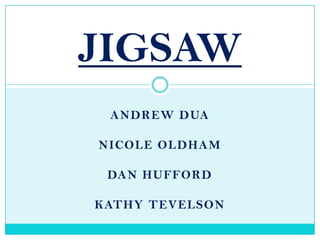
Jigsaw presentation
- 1. Andrew Dua Nicole Oldham Dan Hufford Kathy Tevelson JIGSAW
- 2. WHAT IS JIGSAW? Jigsaw is a cooperative learning technique that has been proven to increase educational outcomes and reduce racial tension. Jigsaw in the classroom involves students each learning a part of a lesson and then sharing their information in groups until all group members understand the complete lesson. Students each act as a piece of the puzzle who together make up a bigger picture.
- 3. THE HISTORY OF JIGSAW: Jigsaw was first used in 1971 in Austin, Texas by Professor Aronson. It was created out of necessity to help ease racial tensions in the desegregation process of a hostile Texas school. Jigsaw was implemented widely by teachers after its initial stages proved to increase confidence in students, reduce absences, increase academic performance, and increase test scores in impoverished areas.
- 4. JIGSAW IN TEN EASY STEPS 1.) Divide students into 5- or 6-person jigsaw groups. The groups should be diverse in terms of gender, ethnicity, race, and ability. 2.) Appoint one student from each group as the leader. Initially, this person should be the most mature student in the group. 3.) Divide the day's lesson into 5-6 segments. For example, if you want history students to learn about Eleanor Roosevelt, you might divide a short biography of her into stand-alone segments on: (1) Her childhood (2) Her family life with Franklin and their children (3) Her life after Franklin contracted polio (4) Her work in the White House as First Lady (5) Her life and work after Franklin's death
- 5. JIGSAW IN TEN EASY STEPS 4.) Assign each student to learn one segment, making sure students have direct access only to their own segment. 5.) Give students time to read over their segment at least twice and become familiar with it. There is no need for them to memorize it. 6.) Form temporary "expert groups" by having one student from each jigsaw group join other students assigned to the same segment. Give students in these expert groups time to discuss the main points of their segment and to rehearse the presentations they will make to their jigsaw group. 7.) Bring the students back into their jigsaw groups.
- 6. JIGSAW IN TEN EASY STEPS 8.) Ask each student to present her or his segment to the group. Encourage others in the group to ask questions for clarification. 9.) Float from group to group, observing the process. If any group is having trouble (e.g., a member is dominating or disruptive), make an appropriate intervention. Eventually, it's best for the group leader to handle this task. Leaders can be trained by whispering an instruction on how to intervene, until the leader gets the hang of it. 10.) At the end of the session, give a quiz on the material so that students quickly come to realize that these sessions are not just fun and games but really count. Source: http://www.jigsaw.org/steps.htm
- 7. EXAMPLE: The students in a history class are divided into small groups of five or six students each. Suppose their task is to learn about World War II. In one jigsaw group, Sara is responsible for researching Hitler's rise to power in pre-war Germany. Another member of the group, Steven, is assigned to cover concentration camps; Pedro is assigned Britain's role in the war; Melody is to research the contribution of the Soviet Union; Tyrone will handle Japan's entry into the war; Clara will read about the development of the atom bomb. Eventually each student will come back to her or his jigsaw group and will try to present a well-organized report to the group. The situation is specifically structured so that the only access any member has to the other five assignments is by listening closely to the report of the person reciting. Thus, if Tyrone doesn't like Pedro, or if he thinks Sara is a nerd and tunes her out or makes fun of her, he cannot possibly do well.
- 8. WHY IS JIGSAW BENEFICIAL? It is a very efficient way to learn new material. Jigsaw encourages listening, engagement, and empathy because each group member has a crucial role to play in the assigned lesson. Group members must work together as a team to accomplish a common goal; each person depends on all the others. No student can succeed completely unless everyone works well together as a team. Jigsaw uses "cooperation by design" a method that facilitates interaction among all students in the class, leading them to value each other as contributors to their common task.
- 9. VIDEO CLIP: COOPERATIVE LEARNING IS A VERY EFFECTIVE TEACHING STRATEGY :-)
- 10. RESOURCES: http://www.jigsaw.org/overview.htm http://www.jigsaw.org/history.htm http://www.jigsaw.org/steps.htm http://www.jigsaw.org/tips.htm http://www.jigsaw.org/links.htm http://www.youtube.com/watch?v=HEh8Z0sbiRE&feature=related
